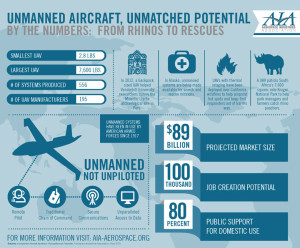The U.S. Department of Transportation’s Federal Aviation Administration (FAA) today released its first annual Roadmap outlining efforts needed to safely integrate unmanned aircraft systems (UAS) into the nation’s airspace. The Roadmap addresses current and future policies, regulations, technologies and procedures that will be required as demand moves the USA from today’s limited accommodation of UAS operations to the extensive integration of UAS into the Next Generation Air Transportation System (NextGen) in the future.
“Government and industry face significant challenges as unmanned aircraft move into the aviation mainstream,” said U.S. Transportation Secretary Anthony Foxx. “This Roadmap is an important step forward that will help stakeholders understand the operational goals and safety issues we need to consider when planning for the future of our airspace.”
The Roadmap outlines the FAA’s approach to ensuring that widespread UAS use is safe, from the perspective of accommodation, integration, and evolution. The FAA’s main goal for integration is to establish requirements that UAS operators will have to meet in order to increase access to airspace over the next five to 10 years. The Roadmap discusses items such as new or revised regulations, policies, procedures, guidance material, training and understanding of systems and operations to support routine UAS operations.
“The FAA is committed to safe, efficient and timely integration of UAS into our airspace,” said FAA Administrator Michael Huerta. “We are dedicated to moving this exciting new technology along as quickly and safely as possible.”
[nonmember] [/nonmember][ismember]
[/nonmember][ismember] [/ismember]Expanding the Utilization of UAS
[/ismember]Expanding the Utilization of UAS
“Our FAA forecast estimates that we can expect 7,500 small unmanned aircraft in our national airspace in the next five years, provided the regulations are in place to handle them.” Huerta added, “For the last two decades, the FAA has authorized the limited use of unmanned aircraft for important missions in the public interest. These include firefighting, disaster relief, search and rescue, law enforcement, border patrol, military training, and testing and evaluation. About 80 law enforcement agencies already operate unmanned aircraft now under special certificates of authorization. Universities also use unmanned aircraft for research into weather, agriculture, and industrial uses.”
The Roadmap also addresses the evolution of UAS operations once all requirements and standards are in place and are routinely updated to support UAS operations as the National Airspace System evolves over time. The document stresses that the UAS community must understand the system is not static, and that many improvements are planned for the airspace system over the next 15 years.
The FAA plans to select six UAS test sites to begin work on safely integrating UAS into the airspace. These congressionally-mandated test sites will conduct critical research into how best to safely integrate UAS systems into the national airspace over the next several years and what certification and navigation requirements will need to be established.
Welcoming the FAA initiative, Michael Toscano, president & CEO of the Association for Unmanned Vehicle Systems International (AUVSI) said that UAS would have great economic contribution in commercial and agricultural fields as well as in public safety, by rapidly responding to natural disasters, locating missing persons and helping to fight wildfires. “UAS can save time, save money, and, most importantly, save lives.” Toscano said, adding that, according to an AUVSI’s economic report projects [ismember](1)[/ismember] he expansion of UAS technology will create more than 100,000 jobs and generate more than $82 billion in economic impact in the first decade following the integration.
Addressing Public Privacy Concern
The use of UAS, both at the designated test sites and in the national airspace generally, raises the issue of privacy and protection of civil liberties. In February, the FAA asked for public comments specifically on the draft privacy requirements for the six test sites. Today, the agency sent a final privacy policy to the Federal Register that requires test site operators to comply with federal, state, and other laws on individual privacy protection, to have a publicly available privacy plan and a written plan for data use and retention, and to conduct an annual review of privacy practices that allows for public comment.
For the next several years, the FAA will continue to use special mitigations and procedures to safely accommodate limited UAS access to the nation’s airspace on a case-by-case basis. The Roadmap notes that this case-by-case accommodation will decline significantly as integration begins and expands, but will continue to be a practical way to allow flights by some UAS operators in certain circumstances.
In addition to the FAA’s Roadmap, as required in the 2012 FAA Reauthorization, the Joint Planning and Development Office (JPDO) has developed a comprehensive plan to safely accelerate the integration of civil UAS into the national airspace system.. That plan details a multi-agency approach to safe and timely UAS integration and coordination with the NextGen shift to satellite-based technologies and new procedures.
In addition to the FAA roadmap, the Department of Transportation is releasing a Comprehensive Plan that dovetails with the FAA’s roadmap. This Comprehensive Plan details the multi-agency approach to the safe and timely integration of unmanned aircraft. The plan establishes goals to integrate both small and larger unmanned aircraft, and to foster America’s leadership in advancing this technology. [ismember]All three of these new documents – the Comprehensive Plan, the Roadmap and the privacy policy for the test sites – are available at FAA.GOV[/ismember].

















